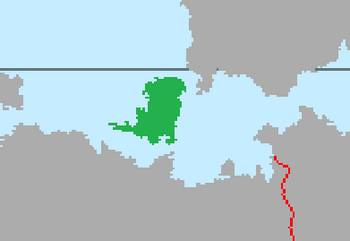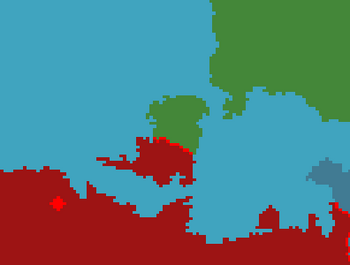Chryse
| Native name: Khrúsē | |
|---|---|
 The island of Chryse. | |
 | |
| Etymology | "Golden" |
| Geography | |
| Area | 24,108 km2 (9,308 sq mi) |
| Administration | |
| Area covered | 12,348 km2 (4,768 sq mi; Template:Pct%) |
| Area covered | 11,760 km2 (4,540 sq mi; Template:Pct%) |
| Demographics | |
| Population | 2,241,843 (2021) |
| Pop. density | 92.99 /km2 (240.84 /sq mi) |
| Languages | Syaran, Górskan |
Chryse is an island located between the continents of Siduri and Eracura on the western "mouth" of the Sundering Sea, marking the end of the Sundering and the beginning of the Sanguine Sea. The island is divided between Syara and Górska, with Syara controlling the southern portion of the island and Górska controlling the northern part. The island is divided nearly equally, with Syara holding 12,348 square kilometers (51.22%) and Górska holding 11,760 (48.78%). The total population of the island is 2,241,843, with a larger Syaran majority (60.41%).
Chryse has been inhabited since Neolithic times. The first recorded human civilization was the Zeliat, originating sometime around 2,800 BCE and establishing dominion over the island by 1,800 BCE. The capital of the Zeliat was Kust and under Zeliat rule the island became known as a place of wealth and prestige; the name Chyrse is derived from the ancient Syaran word Khrúsē, or "golden" in reference to the gold decorations found in Zeliat cities. Zeliat civilization came to abrupt end during the Bronze Age collapse when the island was raided by the Aleitians, who sacked Kust and most of the other major Zeliat settlements. Zeliat culture rapidly declined and following the onset of Hellenic colonists from Syara it disappeared from history entirely. Starting in the 7th Century BCE Chryse came under the dominion of colonists from the Kydonian League and Ancient Makedon, eventually being incorporated entirely into the Makedonian Empire after the 3rd Century BCE.
The island was hit moderately hard by the Burning Plague in the 9th Century, after which the increasing Slavization of Górska led to steady waves of Górskan settlers in northern Chryse. This continued on past the Fall of the Makedonian Empire and eventually resulted in conflict between Górska and the Rioni Union in the 17th Century. The result of the conflict effectively split the island into northern and southern portions, with Syaran control of the south and Górskan control of the north. Tensions over control of Chryse would boil over into another conflict in the mid-1800s that drew in major powers from across Tyran, but failed to result in lasting change concerning control of Chryse. A final third conflict in the 1890s ended with the Treaty of Chryse between Górska and the Republic of Syara which saw both sides agree to recognize each other's claims and established an official border. The treaty was renewed in 1989 with the Commonality of Syara following the end of the Syaran Civil War.
Modern Chryse is a popular tourist destination for its historical ruins and majestic beaches. Much of the island's economy centers around tourism, with textiles, fishing, and shipping forming additional industries. Owing to its strategic geographic position, Chryse boasts significant military importance to both the Górskan Defense Forces and the Syaran Commonality Armed Forces, the latter which operates Chryse Regional Command. The terms of the Chryse treaty limit troop numbers to 20,000 on each side and forbid either nation from authorizing the presence of foreign troops on the island.